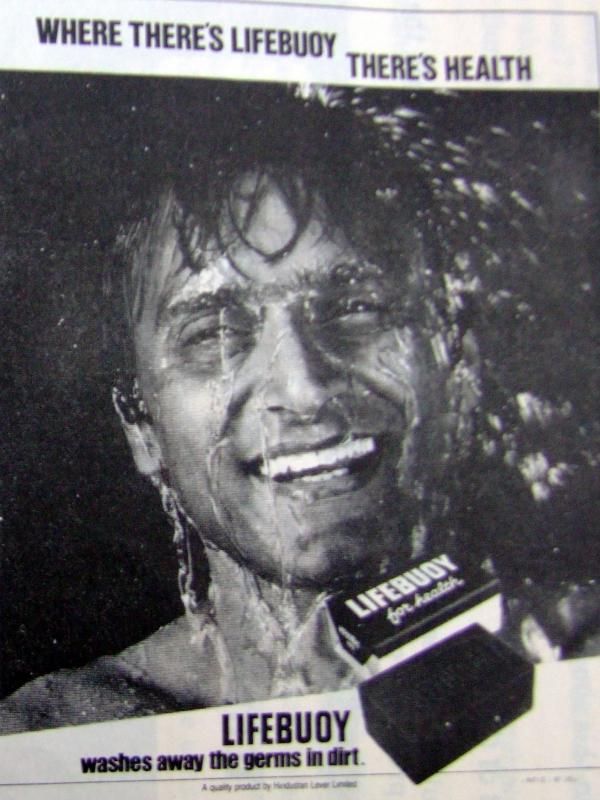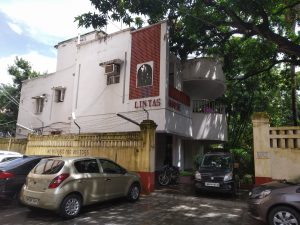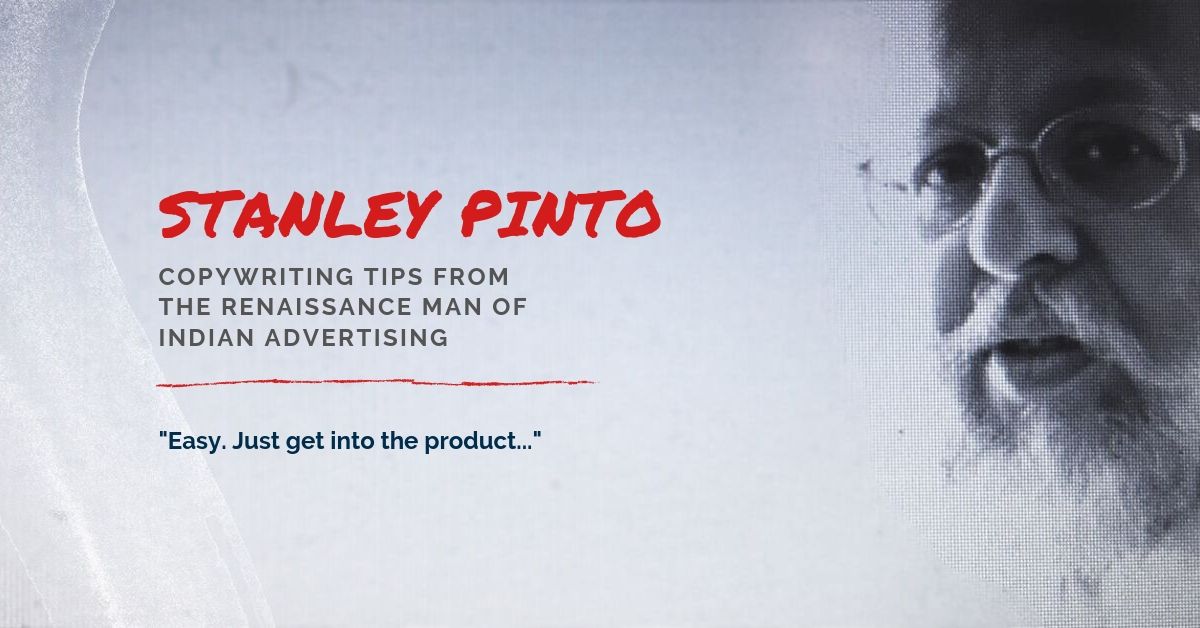There’s absolutely no reason why advertising legend Stanley Pinto should give me an interview.
Yes, I had infrequently tried my hand at advertising copy writing, rather unsuccessfully. The fact that I did that to tide over my frequent bouts of depression as a natural fallout of being a documentary script writer, isn’t a strong enough reason to impress him – that’s for sure.
I always wanted to learn the secrets of writing a good copy. My primary incentive was misdirected towards the axiom of 'money earned per word'; an average copywriter earns three times the money by writing 5 words than I earn writing 5000 words – but why!! I never understood.
And once in a while when I got into the big agency grind, I could never fathom why they spend three weeks to come up with three words. Copy writing became an enigma for me, like women. Could never understand the logic that drives them.
That’s gender insensitive; excuse me my lady readers, if any.
Let’s get back to the Stanley Pinto story before I am thrown overboard, or my wife reads this.
My dear friend Indranil, an old timer with Lintas, mentioned to me that Lintas Kolkata is gearing up to celebrate its 50 years anniversary. He also told me how Mr. Pinto, a jazz pianist turned copywriter from Bombay, was sent to take over the first outpost of Lintas Kolkata – which was set up in a single room dank chamber in the Hindustan Lever office at Ilaco House, Brabourne Road. The way he told the story was absorbing and passionate – to say the least.
Stanley Pinto transformed what seemed like a punishment posting into the dizzy heights of advertising greatness; he catapulted Lintas into becoming the wild-card of advertising in the decadently under-sexy market of Calcutta in the Seventies.
But that’s a story for Lintas Kolkata to tell. I am sure they will; soon enough.
For me I will restrain myself to cut the long story short; Indranil put me across to Mr. Pinto through his former secretary at Lintas Kolkata, Colleen. Rather shaky, I wrote him a letter asking for an interview. Imagine my audacity – asking Stanley Pinto of Lintas Worldwide for copy writing tips for the readers of a newbie blog.
To my greatest surprise, he responded the very next day, with a set of answers that I will cherish for a long time to come. Here they are.
1. You started your career as a copywriter – was it a choice or a compulsion?
Compulsion. I was a nightclub musician for five years and became disillusioned with it as a career choice. The only other skill I had, such as it was, was writing. Journalism wouldn’t have paid for my two cartons a month cigarette habit, so advertising was the fall back.
2. In other words – who should choose copywriting as a career?
Anyone who enjoys, and is a natural at, selling an idea or service or product to an audience that may or may not be interested in it in the first instance; and is willing to work hard at studying the idea/service/product in depth and the competition, with the intent of creating a brand that is unique.
3. How is copywriting different from other forms of writing - say journalism?
Copywriting is as different from journalism as a love letter is from an essay on Biodynamics. The former has to get under the skin of the reader, to create a brand from out of a product and then build an insatiable urge in the target audience to buy the brand, repeatedly. Journalism is about informing the public about goings-on in the world and their social milieu.
On the other hand, Copywriting is the other side of the same coin as writing fiction, biographies etc. They all require a modicum of creativity to attract the target audiences’ attention.
4. What makes an effective advertising copy? Or, what are your expectations from a good copy? Can you please illustrate with a few personal examples.
I lived by UPGA, the first principles of good advertising that I learnt when I joined Lintas in 1964. Nothing has changed in the purpose of advertising to change those principles. They follow further below in this interview.
5. How important is a good brief to write a good copy? How would you brief your copywriter?
A copywriter must know everything there is to know about the product: how it is made, what are its special attributes and features, the market it is to play in, who are the likely competitors. Only then will the copywriter be able to transform the product into a brand.
Lux was a product used for cleansing the body, and like any other soap it is made from a combination of animal fat or plant oil and caustic soda, with perfume added. It took a copywriter, seventy-five years ago, to transform it into “the beauty soap of the film stars”. That was the transformation from product to brand. It made Lux the top selling bath soap in the world. I suspect it still is.
Around the same time, Unilever came up with Lifebuoy soap, with carbolic added to the usual lump of animal fat. It was cheaper than other bath soaps. It smelled different from any other soap, and not necessarily in a pleasant way. Then Lintas came up with the slogan ‘Lifebuoy for Health’. That gave the smell of the carbolic a reason for being. And Lifebuoy became the second-largest selling soap in India.
 That sure is a kickback from the past.
That sure is a kickback from the past.
6. What are the sources of inspiration for an advertising copywriter?
Easy. Just get into the product.
As I said earlier, a copywriter must know everything there is to know about the product: how it is made, what are its special attributes and features, the market it is to play in, who are the likely competitors. Only then will the copywriter be able to transform the product into a brand.
When an ad agency’s income came from the 15% commission they earned from the media, it used to be said that Advertising was 85% perspiration and 15% inspiration.
That perspiration . . . the hard work . . . the understanding of what makes your product tick . . . is what will provide the inspiration to convey why the consumer cannot – should not - do without it in preference to all others.
7. What would be your advice for aspiring copywriters?
Be prepared to work your ass off. If you don’t know as much about a product as its producer does, from its manufacturing process to its selling processes, and the market forces that will drive it . . . you will be nothing more than a hack, making a living you don’t deserve.
Now for the UPGA, or the UNILEVER PLAN FOR GREAT ADVERTISING, That Mr. Pinto was referring to in response to question 4 above.
THE UNILEVER PLAN FOR GREAT ADVERTISING
- IT CONCENTRATES ON ONE BIG IDEA.
The Brand’s benefit conveyed through one single-minded idea. A visual or aural expression of that one key concept to be linked to the Brand. Arresting, exciting, unexpected.
- ITS PROMISE DIFFERENTIATES THE BRAND FROM ITS COMPETITION.
The Benefit must be unique. Something that isn’t just relevant but SPECIAL TO YOUR BRAND, something the others don’t have (and if they copy you later, that’s OK, Me-too ads are the best form of flattery, they seldom go anywhere, and they usually reinforce your Brand.)
- IT INVOLVES THE TARGET CONSUMER.
It creates an immediate impact, grabs attention by appealing to your target consumers’ self-interest, relating to a real need or problem and promising satisfaction of it..
- IT ESTABLISHES A RELATIONSHIP WITH THE CONSUMER.
A relationship that reeks of Understanding. The situations shown, the presentation style, the people depicted, the language and tone of voice used – all must reveal your understanding of and sympathetic with the consumers’ life.
- IT IS CREDIBLE, IT FEELS GENUINE.
The statements made, the demonstrations shown, must be fully acceptable as fact. Hyperbole and humour are fine (perhaps even desirable) but the fundamental Brand benefit must always feel obtainable.
- IT IS SIMPLE AND CLEAR.
Murphy’s Law slightly adjusted: If anything can be misunderstood, it will be. Count on it. Look out for ambiguity; it is the bête noire of effective communication. Avoid smart executions if they can, even to some people, be too smart alecky to be understood. Also, too many thoughts, too many impressions will confuse and overwhelm and lose the attention. Keep It Simple.
- IT INTEGRATES THE BRAND NAME WITH THE CENTRAL IDEA.
The Big Idea must belong and be linked exclusively to the Brand. Whether it is a Visual or Aural or Written idea, every sighting of it, even in totally unrelated situations or contexts, must bring the memory of the Brand to mind.
- IT TAKES FULL ADVANTAGE OF THE MEDIUM.
Each medium has its own characteristics. The Big Idea should be adaptable to each medium, and take full advantage of its fundamental characteristics and opportunities so that the ad would seem to have been created primarily for that medium.
- IT IS CAMPAIGNABLE.
The Big Idea must ‘have legs’ so it is not just an ad, but can be spun out into a campaign. It must have stamina so it doesn’t end with just the campaign but goes on to campaign after campaign, year after year. The Big Idea must endure – the campaigns may change to suit the times.
- IT MUST HELP TO BUILD A BRAND PERSONALITY.
Each advertisement, whether theme or one-off, affects the consumer’s perception of the Brand; every ad that conflicts with the Brand’s essential personality erodes and weakens it. What each ad should be doing is building, reinforcing or, at the very least, confirming the Brand Personality.
Hmm…that’s not all.
Mr. Pinto has also generously allowed me to share with you a speech he delivered to the Advertising Club Kolkata – in 2003. It’s loaded with scintillating anecdotes and good-natured leg-pulling that used to be the hallmark of the advertising fraternity of yesteryears.
I present you a brief sample.
A LIFE (and other leaps of incredulity) IN ADVERTISING
R K Sarkar Memorial Lecture
Delivered to the Advertising Club Calcutta
11 December 2003
I look out at you, and I feel like a dinosaur. I am a dinosaur.
I left India in 1984, after exactly twenty years in Advertising in India– and when I returned, everything had changed. It’s all so thrilling, so fast and furious, so risqué today. Everything is so different.
For example, in our time, you never ever made unsolicited pitches for other people’s accounts. It simply wasn’t done. Once in 1982, I casually spoke – just spoke – to the Managing Director of one of Bal Mundkur’s clients at a party somewhere. Safari Luggage, I believe he was. But I must have had the gleam of greed in my eye, because Bal was so furious he went out and stole my Hongkong Bank account, just to show me he could do better what I wasn’t supposed to do in the first place.
I got my backside right royally scalded by the bosses at Lintas – who then even apologised to Bal for my unprofessional behaviour. Safari Luggage has long disappeared. Bal has sold Ulka and is living the life of a country squire in Goa. But the Hongkong Bank account is still a huge one – and Lintas never ever got it back.
Today, it’s all so different. All your CEOs seem to be doing is raiding the competition’s larders, with impunity….
The entire speech is available in a PDF Download. Click HERE.
For those readers not from the world of advertising, and who might be too weary to Google Stanley Pinto, here’s a very short introduction.
THE RENAISSANCE AD-MAN
A New York Journal once described Stanley Pinto as ‘a Renaissance man: jazz pianist, writer and author, art collector, stage actor and irrepressible bon vivant’. That’s just a few of his attributes, I must say.
He did spend 30 odd years as an advertising professional in India and South East Asia, but for me, his greatest stint was probably his brand building days with Lintas Kolkata – grabbing attention in a somewhat stale market with one campaign after the other. Dettol; Disprin; British Paints’; Luxol Silk; Union Carbide’s Eveready batteries.
It’s a long and nostalgic list that covers most of my childhood.
That apart, Mr Pinto has had stints as President of Advertising Club Calcutta for five years; Chairman of the Members’ Committee, Bankers Club, Kuala Lumpur; the only non-Malaysian member of the Advertising Standards Authority of Malaysia; the first Asian President of The International Wine & Food Society, Malaysia; Management Consultant to the Ministry of Information and The Zubair Corporation, Sultanate of Oman.
A minute after his 50th Birthday in 1993, he withdrew from corporate life. His last assignment was as the Managing Director of Bozell Malaysia, Chairman of Bozell Singapore and Regional Director of Bozell South- & South-east Asia, simultaneously.
So when he talks about copywriting just shut your crap up and listen.
And many thanks Indranil for making this happen.
I say that at the fag end here, because I know this time you will reach here, for a change. That’s another achievement. You probably have never read anything that I have written beyond 50 words. Or less.
This one, I am sure, will make you come out of yours, what’s that you call that – your 30-second mindset…
After all, it’s about and by Stanley Pinto. Should I say more?

I too have quite a few happy memories of the Lintas House.


This was eye opening, and to my mind, fortuitous at many levels. A wonderfully informative and lucid piece, with such great advice from the god of advertising before Prasoon Joshi and Piyush Pandey…Thoroughly enjoyed it! 😊
Yes. Download the speech and read it Parna … it’s a bit of a long read, but you won’t be able to put it down, I promise you.
Wonderful
Thanks Nishi. How is your book launch coming up. Travel writing should be a fun thing to explore next.
I was in class V when i had to answer a question in my english language paper: Your Aim In Life. Being deeply influenced by a father who was a copywriter himself, I wrote about my dream to be in advertising. In a time and age when being a doctor or an engineer or atleast a banker was the politically correct thing to say, naturally my preposterous answer led to an immediate guardian call.
Having spent about 25 years in advertising I must admit that I loved reading your blog … every word of it. This is like a ready reckoner for every advertising wannabe and for old hands like us who are still learning the trade.
And, sure… I loved the ending… Yes, I read every word of it for a change and kept asking for more. Ready to read even lengthier blogs on the men and women who changed the course of my life. For good.
Wow. 158 words. Proud of you Indra. And many thanks again.
Thoroughly enjoyable….
Thanks Gautam. You have always been very encouraging.
Thanks for sharing.
It’s more like eye opener for me. Thoroughly enjoyed reading this.
Thanks Swagata.
This was such a good read. As a millennial content developer with a ’30-second-mindset’ and a ’15-second-attention-span’, I must say: 3 paragraphs into this post and I bookmarked it for future reference. I know I will look back at it quite often in the future. 🙂
And thanks for the link to Mr. Pinto’s speech. It was as riveting as it was enlightening. Granted that the advertising landscape has evolved since, the values that drive ad consumption on media platforms and role of good copy hasn’t changed much.
Once again, thanks for the post. Looking forward to more 🙂
Of course. I have diverted into other areas, but will sure plan something on advertising / copy writing soon. That domain is kind of like my ‘other wife’ – have to keep meeting to sustain the relationship. Thanks for your comment Sam.